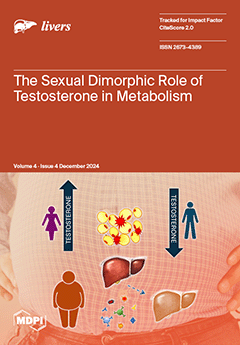Background: Unlike other chronic liver disorders, in primary biliary cholangitis (PBC), systemic oxidative stress (SOS) worsens along with liver disease progression status (DPS), influencing muscle metabolism, muscle quantity (MQ), and itch pathways. Synergistically, cholestasis contributes to reduced vitamin D absorption, with a negative
[...] Read more.
Background: Unlike other chronic liver disorders, in primary biliary cholangitis (PBC), systemic oxidative stress (SOS) worsens along with liver disease progression status (DPS), influencing muscle metabolism, muscle quantity (MQ), and itch pathways. Synergistically, cholestasis contributes to reduced vitamin D absorption, with a negative impact on MM and SOS. Despite this evidence, the prevalence of sarcopenia in PBC, and the SOS-MQ relationship comparing PBC with other CLDs, has never been investigated. Moreover, the relationship between vitamin D and MQ-SOS, and the correlation between SOS and pruritus severity, remains unexplored in PBC.
Methods: A total of 40 MASLD, 52 chronic HBV infections, 50 chronic HCV infections, and 41 ursodeoxycholic acid/antioxidant-naïve PBC patients were enrolled. Biochemical, nutritional, and liver stiffness (LSM) data were collected, and sarcopenia was assessed after a normalizing 3-month dietetic–physical exercise regimen. The d-ROMs/BAP tests evaluated SOS. The validated “PBC-40 questionnaire” estimated pruritus and quality of life (QoL).
Results: Unlike other CLDs, in PBC patients, sarcopenia was more prevalent in initial mild fibrosis (PBC: 57.10% vs. MASLD: 30.76%, HBV: 22.60%, HCV: 20.70%, all
p < 0.0001), and SOS significantly correlated with MQ (dROMs-ASM/h
2,
p: 0.0002; BAP-ASM/h
2:
p: 0.0092). PBC patients presented lower vitamin D levels and a significant correlation of these with SOS and MQ (all
p < 0.0001). SOS also correlated with pruritus severity (dROMs, R: 0.835; BAP, R: −0.775,
p < 0.0001). QoL impairment was significantly more represented in PBC individuals with sarcopenia, SOS imbalance, and relevant pruritus (
p: 0.0228).
Conclusions: In PBC, SOS correlates with MQ impairment and pruritus severity, configuring two independent relationships simultaneously impacting QoL.
Full article





